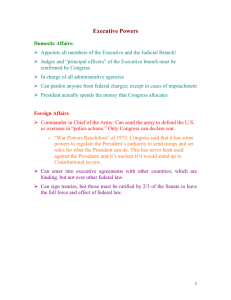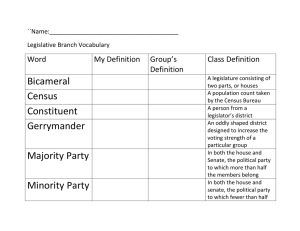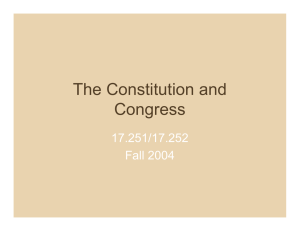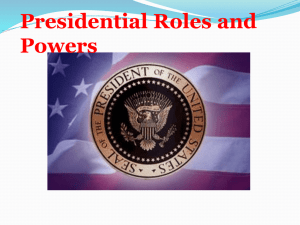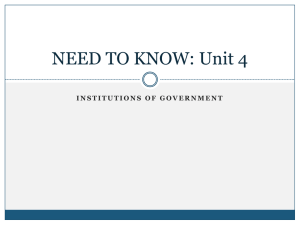Constitutional foundations, powerpoint
advertisement
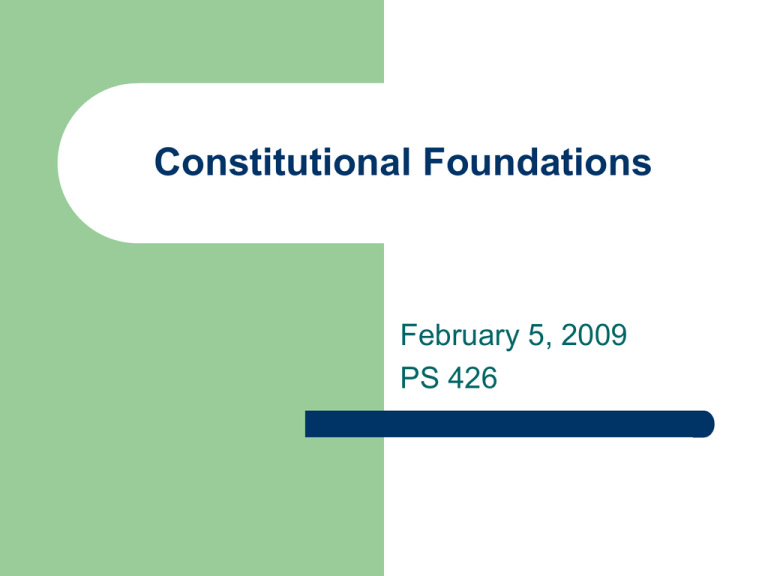
Constitutional Foundations February 5, 2009 PS 426 Context for the Constitutional Convention British Parliament State legislatures Continental Congress -- Articles of Confederation – – Articles created a national unicameral legislature with lawmaking power, with each state having one vote. Weak internal procedures and structure. No executive branch or national courts: states responsible for implementing laws. Desire to strengthen the national government while preventing majority tyranny. Separation of powers and checks and balances. The Basic Structure Problem of representation: large state/small state debate. – – – Virginia Plan: strong national government with representation based on population; New Jersey Plan: equal repr. Connecticut Compromise: bicameralism, Senate based on equal representation, House based on population. CT as median voter. STRUCTURE, cont. Bicameralism — Does small state bias in Senate make a difference today? – – – – funding formulas issues of interest to farmers and rural people (guns, grazing rights) do small states have a leadership advantage? Impact on the electoral college. Each chamber makes its own rules of procedure, elects its own leaders. Senate as a continuing body, House newly constituted every two years. Checks and Balances Complete separation from executive – – – – separate elections, separate fixed term length no simultaneous service (prevents a parliamentarystyle system) for members of Congress and the executive branch or courts. However, executive branch members may serve on federal courts. limited executive use of prosecutorial power against Congress (immunity). William Jefferson case. Check each other: impeachment power, legislative veto and executive veto power. POWERS OF CONGRESS: Enumerated Many were specific responses to Confederation Congress’s problems. Coin money, establish roads and post offices, grant patents, create the court system, raise and support armies, etc. “Power of the purse” is central. Taxing and spending. “regulate commerce . . . among the several states” – – 19th Century definition: Narrowly interpreted, inter-state/intrastate commerce. Post-New Deal definition: broad, basis for Civil Rights Act of 1964 and many other laws. U.S. v. Lopez (1995) and United States v. Morrison (2000) signify a new trend. POWERS OF CONGRESS: Implied and Shared Implied powers – Elastic clause: “necessary and proper” McCulloch vs. Maryland (1819). Shared powers – – – – judicial selection confirmation of executive appointments creating and funding executive branch agencies foreign policy/defense; Congress declares war and “raises and supports armies,” but President is commander-in-chief. Senate ratify treaties. LIMITATIONS ON CONGRESSIONAL POWER In the original text of Constitution: no ex post facto laws, bills of attainder, or grants of title of nobility. The Bill of Rights and other constitutional provisions serve as important checks on the scope of legislation: – examples of Federal laws struck down as unconstitutional: original Federal Election Campaign Act (1976), anti-flag burning law (1990), Line-Item Veto Law (1998), Religious Freedom Restoration Act (1997), Violence Against Women Act (2000). Separation of powers: “dual security” Other branches and the states (veto power, judicial review and federalism; good examples of the latter are education, law enforcement, and election administration).




